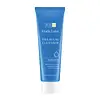What's inside
What's inside
 Key Ingredients
Key Ingredients

 Benefits
Benefits

 Concerns
Concerns

 Ingredients Side-by-side
Ingredients Side-by-side

Water
Skin ConditioningGlycerin
HumectantSodium Cocoyl Glycinate
CleansingButylene Glycol
HumectantHydroxypropyl Starch Phosphate
Cocamidopropyl Betaine
CleansingPEG-400
Emulsion StabilisingLauryl Glucoside
CleansingSodium Lauroyl Aspartate
CleansingStearyl Alcohol
EmollientCitric Acid
BufferingPolyquaternium-7
Glyceryl Stearate
EmollientPEG-60 Glyceryl Stearate
EmulsifyingSodium Hyaluronate
HumectantMagnesium Ascorbyl Phosphate
AntioxidantHydroxypropyltrimonium Hyaluronate
Tranexamic Acid
AstringentHydrolyzed Hyaluronic Acid
HumectantTocopherol
AntioxidantSaccharomyces/Coix Lacryma-Jobi Ma-Yuen Seed Ferment Filtrate
Skin ConditioningCoix Lacryma-Jobi Ma-Yuen Seed Extract
Skin ConditioningHydroxypropyl Methylcellulose
Emulsion StabilisingDisodium EDTA
BHT
AntioxidantSodium Metabisulfite
AntioxidantSodium Benzoate
MaskingPhenoxyethanol
PreservativeWater, Glycerin, Sodium Cocoyl Glycinate, Butylene Glycol, Hydroxypropyl Starch Phosphate, Cocamidopropyl Betaine, PEG-400, Lauryl Glucoside, Sodium Lauroyl Aspartate, Stearyl Alcohol, Citric Acid, Polyquaternium-7, Glyceryl Stearate, PEG-60 Glyceryl Stearate, Sodium Hyaluronate, Magnesium Ascorbyl Phosphate, Hydroxypropyltrimonium Hyaluronate, Tranexamic Acid, Hydrolyzed Hyaluronic Acid, Tocopherol, Saccharomyces/Coix Lacryma-Jobi Ma-Yuen Seed Ferment Filtrate, Coix Lacryma-Jobi Ma-Yuen Seed Extract, Hydroxypropyl Methylcellulose, Disodium EDTA, BHT, Sodium Metabisulfite, Sodium Benzoate, Phenoxyethanol
Water
Skin ConditioningSodium Cocoyl Glycinate
CleansingPropylene Glycol
HumectantCoco-Betaine
CleansingAcrylates Copolymer
Pentylene Glycol
Skin ConditioningPEG-150 Pentaerythrityl Tetrastearate
EmulsifyingGlycerin
HumectantPPG-2 Hydroxyethyl Cocamide
EmulsifyingOryza Sativa Powder
Niacinamide
SmoothingFortunella Margarita Fruit Extract
Skin ConditioningActinidia Chinensis Fruit Extract
EmollientHelichrysum Italicum Flower Oil
MaskingSodium Dilauramidoglutamide Lysine
HumectantMelia Azadirachta Extract
Skin ConditioningButylene Glycol
HumectantSodium Hyaluronate
HumectantHydrolyzed Sodium Hyaluronate
Skin ConditioningSodium Acetylated Hyaluronate
HumectantCitrus Aurantium Dulcis Fruit Extract
MaskingCitrus Grandis Fruit Extract
AstringentPolyquaternium-39
Titanium Dioxide
Cosmetic ColorantDisodium EDTA
Sodium Hydroxide
BufferingPhenoxyethanol
PreservativeSodium Benzoate
MaskingWater, Sodium Cocoyl Glycinate, Propylene Glycol, Coco-Betaine, Acrylates Copolymer, Pentylene Glycol, PEG-150 Pentaerythrityl Tetrastearate, Glycerin, PPG-2 Hydroxyethyl Cocamide, Oryza Sativa Powder, Niacinamide, Fortunella Margarita Fruit Extract, Actinidia Chinensis Fruit Extract, Helichrysum Italicum Flower Oil, Sodium Dilauramidoglutamide Lysine, Melia Azadirachta Extract, Butylene Glycol, Sodium Hyaluronate, Hydrolyzed Sodium Hyaluronate, Sodium Acetylated Hyaluronate, Citrus Aurantium Dulcis Fruit Extract, Citrus Grandis Fruit Extract, Polyquaternium-39, Titanium Dioxide, Disodium EDTA, Sodium Hydroxide, Phenoxyethanol, Sodium Benzoate
Ingredients Explained
These ingredients are found in both products.
Ingredients higher up in an ingredient list are typically present in a larger amount.
Butylene Glycol (or BG) is used within cosmetic products for a few different reasons:
Overall, Butylene Glycol is a safe and well-rounded ingredient that works well with other ingredients.
Though this ingredient works well with most skin types, some people with sensitive skin may experience a reaction such as allergic rashes, closed comedones, or itchiness.
Learn more about Butylene GlycolDisodium EDTA plays a role in making products more stable by aiding other preservatives.
It is a chelating agent, meaning it neutralizes metal ions that may be found in a product.
Disodium EDTA is a salt of edetic acid and is found to be safe in cosmetic ingredients.
Learn more about Disodium EDTAGlycerin is already naturally found in your skin. It helps moisturize and protect your skin.
A study from 2016 found glycerin to be more effective as a humectant than AHAs and hyaluronic acid.
As a humectant, it helps the skin stay hydrated by pulling moisture to your skin. The low molecular weight of glycerin allows it to pull moisture into the deeper layers of your skin.
Hydrated skin improves your skin barrier; Your skin barrier helps protect against irritants and bacteria.
Glycerin has also been found to have antimicrobial and antiviral properties. Due to these properties, glycerin is often used in wound and burn treatments.
In cosmetics, glycerin is usually derived from plants such as soybean or palm. However, it can also be sourced from animals, such as tallow or animal fat.
This ingredient is organic, colorless, odorless, and non-toxic.
Glycerin is the name for this ingredient in American English. British English uses Glycerol/Glycerine.
Learn more about GlycerinPhenoxyethanol is a preservative that has germicide, antimicrobial, and aromatic properties. Studies show that phenoxyethanol can prevent microbial growth. By itself, it has a scent that is similar to that of a rose.
It's often used in formulations along with Caprylyl Glycol to preserve the shelf life of products.
Sodium Benzoate is a preservative. It's used in both cosmetic and food products to inhibit the growth of mold and bacteria. It is typically produced synthetically.
Both the US FDA and EU Health Committee have approved the use of sodium benzoate. In the US, levels of 0.1% (of the total product) are allowed.
Sodium benzoate works as a preservative by inhibiting the growth of bacteria inside of cells. It prevents the cell from fermenting a type of sugar using an enzyme called phosphofructokinase.
It is the salt of benzoic acid. Foods containing sodium benzoate include soda, salad dressings, condiments, fruit juices, wines, and snack foods.
Studies for using ascorbic acid and sodium benzoate in cosmetics are lacking, especially in skincare routines with multiple steps.
We always recommend speaking with a professional, such as a dermatologist, if you have any concerns.
Learn more about Sodium BenzoateSodium Cocoyl Glycinate is a cleansing agent. It can be naturally derived or synthetically-created.
As a surfactant, it helps clean your skin by gathering dirt, oil, and other pollutants to be rinsed away more easily.
Sodium Hyaluronate is hyaluronic acid's salt form. It is commonly derived from the sodium salt of hyaluronic acid.
Like hyaluronic acid, it is great at holding water and acts as a humectant. This makes it a great skin hydrating ingredient.
Sodium Hyaluronate is naturally occurring in our bodies and is mostly found in eye fluid and joints.
These are some other common types of Hyaluronic Acid:
Learn more about Sodium HyaluronateWater. It's the most common cosmetic ingredient of all. You'll usually see it at the top of ingredient lists, meaning that it makes up the largest part of the product.
So why is it so popular? Water most often acts as a solvent - this means that it helps dissolve other ingredients into the formulation.
You'll also recognize water as that liquid we all need to stay alive. If you see this, drink a glass of water. Stay hydrated!
Learn more about Water